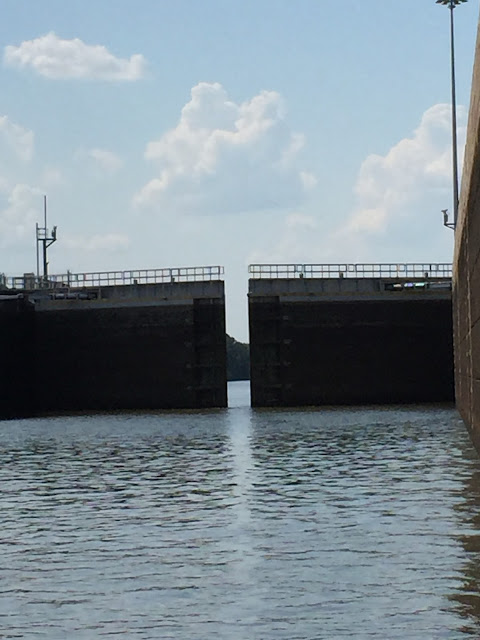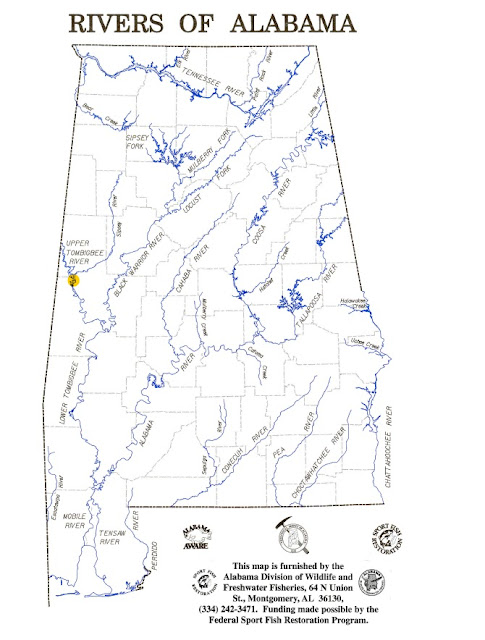22 September 2016
Every morning since we left St.
Petersburg, FL, the captain performs the same inspections without fail
on
Viridian. He gets up at 4:30 AM, careful not to disturb
the sleeping admiral, closes the doors to the berth, turns on the lights in the
galley and lights the 3-eyed galley stove.
Water is poured from one of several gallon jugs we keep on
board for drinking/cooking. While the water is coming to a boil, he
cracks the hatch to the engine compartment and switches on the lights to
illuminate the below-deck machinery. He checks all fluid levels for
both the main engine and the generator. Next, the fuel sight glass tube
valves are opened and fuel levels noted in both port and starboard tanks (then
closed again). Then, each fuel filter is inspected for signs of
dirt/water for both engines. Next, with flashlight in hand,the captain
must duck walk and belly crawl over sharp hose clamps and battery boxes to
inspect the bilge for any signs of excess water or oil leaks from the various
sources. All water hoses are inspected as well as electrical for any
obvious issues. Lastly, the shift/throttle cables are inspected to make
sure they are in proper working condition. Once everything passes
inspections, he closes the three hatches to the engine room and takes the
boiling tea kettle of fresh water off the stove. Two cups of coffee are
made, one is taken to the admiral who is now stirring around in the berth, and
the other is consumed by the captain while he updates the ship's log and plots
a course for the day's destination. By the time this is all done, the
multi-talented galley chef has prepared a breakfast fit for a hungry captain and
crew. This is how each day begins on board
Viridian.
When the time comes to start the engine, the captain uses a checklist developed by his brother,
Richard, while crewing in St. Petersburg. (One of Richard's former
occupations was an aircraft airframe and power plant mechanic/technician.
He developed a very thorough start-up procedure for
Viridian and
the captain has used it ever since).
As the captain was making his rounds on deck, he noticed a
pontoon boat two slips over that had three unshaven men who appeared to have
been sleeping rough the last several days. They were in a huddle
discussing some important matter, so naturally I wondered over to their area
and eventually introduced myself. It turns out the three men had launched
their pontoon boat somewhere around Paducah, Kentucky and were on their way south
to Mobile. Once there, their wives were to pick them up and carry them
back home to KY. When I finished picking their brains, they picked
mine. It is good to get a current situational awareness brief about where
you are going so it was a win/win for both Captains. I can appreciate a
trip like the one they were on. I often dreamed of doing the very same
thing. Glad I waited and got a boat that had a more home-like feeling
though. We quickly exchanged emails as we all had itchy feet about
getting back out on the water.
Viridian was fired up and the multi-talented firstmate
unplugged the 50A power cable (otherwise known as the "yellow dock
line", untied all the mooring lines and brought all the fenders on board
to avoid ripping them off on the dock hardware.
Viridian backed
slowly into the mirror-calm waters of Kingfisher Marina, and with a few burst
of bow thruster she was pointed into the departure channel.
Viridian was
shifted into forward, and with a satisfying clumk, we eased out of the marina
and back into the Tenn-Tom River, headed for our destination.
Our cruise to Upper Cooks Bend Cut-Off anchorage would be
about 62 miles and require locking through the Howell Heflin Lock at MM-266.
We passed under the I-20/59 bridge at MM-239 and cruised within 3 miles of the
Heflin Lock, where we called the Lockmaster on CH-16 by saying, "Howell
Heflin Lock, Howell Heflin Lock, Howell Heflin Lock, this is the
vessel
Viridian." The Lockmaster would respond by
saying, "Heflin Lock, switch to CH-12". I would respond by
saying, "Roger, CH-12", and the multi-tasking radio officer would
hand me our other radio, a mobile marine handheld, already tuned to
CH-12. I would say, "This is the upbound vessel
Viridian,
24 minutes out. Can you get us through?" The Lockmaster would
respond (sometimes minutes later) and tell us what the situation was and if there
was going to be a delay due to commercial traffic or not. We would
continue on at 6.5 kts to find the gates open and the green light on. All
we had to do was enter the lock and maneuver
Viridian to the
innermost bollard and tie up. Once tied, the captain would radio the Lockmaster
and say, "
Viridian is secure and ready to rise.” The Lockmaster
would respond, "Roger", at which point the gigantic steel gates would
slowly moan closed. Not long after, strange noises could be heard deep
within the lock and the water would start stirring as
Viridian was
lifted skyward at a rate of inches per second. At the top of the lock we
would wait for a spell and then see the gates ahead of us start to creep
open. We waited, engine idling, for the LOUD blast from the lock horn
situated too close to the gate. Once we crawled back into our skins, the
multi-tasking firstmate would release our homemade lock loop and say to the captain,
" You have her now, captain". At that point I wouldradio the Lockmaster
on CH-12 and say, "Heflin Lock,
Viridian is free and is
exiting the lock. Thank you for your help,” The Lockmaster responds
saying, "Roger,
Viridian, Have a nice day.” I would respond
by saying, "
Viridian.” This is pretty much the dialog along
the Tenn-Tom Waterway with the numerous Lockmasters. We were told to
remember that the Lockmaster was BOSS. If we kept that in mind it would
make our trip a lot more pleasant.
After exiting Heflin Lock,
Viridian headed
for an "oxbow lake" called Upper Cooks Bend Cut Off. According
to Active Captain, this was a highly recommended anchorage. We approached
the oxbow on the port side and followed the navigation recommendations given in
the comment section of Active Captain. We kept to port and slid
over the sandbar with a foot to spare. Once in the oxbow, we found a deep
and wide channel that slowly bent to the left. At the point where it
turned due south we decided to drop the hook. We anchored in a wide
spot with plenty of swing room, and the view was a nice sea wall with several
upscale houses situated among the trees. There was no current or wind
that we could detect. The anchor set on the first attempt, the ship's
engine was shut down, the generator was cranked and the air conditioners were
turned on full blast.
It didn't take long to cool down the
Salon (or Saloon). The multi-tasking galley chef prepared a scrumptious
dinner complete with adult beverages, and we watched the sun set on a perfectly
calm location. We talked about things like, if we had our dinghy we
could..... and such till our eyes got too heavy to stay open.
That's the news and here's the views:
Cook's Bend Anchorage Location
This is the Tenn-Tom Waterway form Demopolis to Corinth MS
Heading North for our second anchorage at Upper Cooks Bend Cut-Off
Approaching the Howell Heflin Lock & Dam with Blueline Hwy 39 just behind
We have no idea either what this picture is trying to show
White cliffs along the waterway. Haven't gotten my videos working yet
Howell Heflin Lock and Dam – Mile 266.0
- Lift of 36 feet
- 2nd highest lift on the Tenn-Tom
- Located in Greene County near Gainesville, AL
- 6,400-acre Gainesville Lake
- Cost $32.3 million
- 8 recreation areas
The Heflin Lock and Dam is the southernmost structure on the
Tenn-Tom. From here, commercial and recreation vessels reach the
connecting Warrior-Tombigbee Waterway some 53 miles away on an improved
Tombigbee River and the impoundment created by the Demopolis Lock and
Dam. From Demopolis, it is 215 miles to the Gulf of Mexico. Its
impoundment, Gainesville Lake, is 40 miles long and covers 6,400 acres.
The lock and dam is named in honor of former U.S. Senator, Howell
Heflin, of Alabama.
(ref: http://business.tenntom.org/using-the-tenn-tom/locks-and-dams/tennessee-tombigbee-waterway-locks/#heflin)
























































